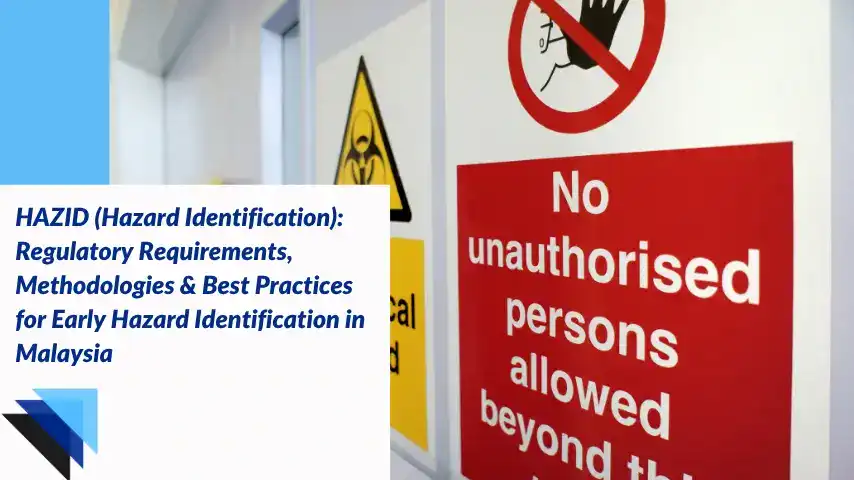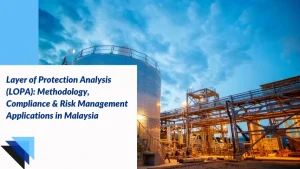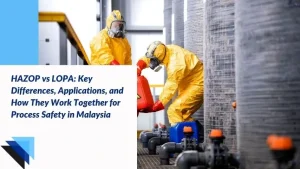HAZID (Hazard Identification) is a systematic process for identifying potential hazards in industrial processes and projects at their earliest stages. In Malaysia, implementing HAZID effectively is not just a best practice; it’s a crucial regulatory requirement for ensuring workplace safety and operational excellence.
Are you looking to enhance your organization’s hazard identification processes while ensuring compliance with Malaysian regulations? This comprehensive guide will walk you through:
- Essential regulatory requirements specific to Malaysia
- Proven HAZID methodologies that deliver results
- Industry-tested best practices for early hazard detection
- Strategic implementation approaches across project phases
- Key considerations for team formation and documentation
Whether you’re a safety professional, project manager, or industry leader in Malaysia, understanding these critical aspects of HAZID will help you build a more robust safety framework. Let’s explore how to implement HAZID effectively while meeting all local regulatory requirements.
Ready to Strengthen Your Hazard Identification Process?
Ensure your organization complies with Malaysia’s regulatory requirements and mitigates risks effectively.
- What Is HAZID and Why Is It Important in Process Safety?
- What Is the Malaysian Regulatory Framework for HAZID?
- What Is the Methodology for Implementing HAZID?
- What Is the Role of Risk Assessment and Management Strategies in HAZID Implementation?
- How Is HAZID Implemented Across Different Project Phases?
- How Does HAZID Integrate with Other Safety Studies?
- What Are the Best Practices and Industry Standards for HAZID?
- How Wellkinetics Can Help
What Is HAZID and Why Is It Important in Process Safety?
HAZID (Hazard Identification) is a systematic approach to identifying potential hazards and risks in industrial processes, projects, or operations. It serves as a foundational element of process safety management, helping organizations prevent accidents and ensure workplace safety.
What Are the Core Components of a HAZID Study?
A comprehensive HAZID study encompasses several essential elements that work together to create an effective hazard identification framework:
1. Systematic Risk Assessment
- Structured evaluation of potential hazards
- Analysis of operational processes
- Documentation of identified risks
- Prioritization based on severity and likelihood
2. Team-Based Approach
- Cross-functional team composition
- Expert involvement from various disciplines
- Collaborative decision-making
- Diverse perspectives for thorough analysis
3. Documentation and Reporting
- Detailed recording of findings
- Clear communication channels
- Action item tracking
- Regular updates and reviews
The HAZID study process involves methodical examination of each system component, operation, or process step to identify potential hazards. This systematic approach ensures nothing is overlooked during the assessment.
Process safety professionals utilize HAZID as an early-warning system to detect potential issues before they escalate into serious problems. The methodology helps organizations maintain safety standards while optimizing operational efficiency.
What Is the Difference Between HAZID and HAZOP Studies in Malaysia?
HAZID is an early-stage hazard identification tool focusing on broader potential hazards during initial project phases, while HAZOP is a detailed operational study conducted later in the project lifecycle. HAZID provides a foundation for subsequent safety studies, whereas HAZOP examines specific process parameters and deviations.
How Does HAZID Contribute to Cost Savings in Malaysian Industrial Projects?
HAZID helps identify potential hazards early in the project lifecycle, preventing costly modifications during later stages. By implementing proactive safety measures, companies can avoid accidents, reduce downtime, improve operational efficiency, and minimize regulatory compliance issues.
RELATED: Understanding Process Hazards and How to Effectively Address Them
Is Your Safety Framework Robust Enough?
Don’t wait for incidents to expose hidden hazards. Get ahead with early hazard identification.
What Is the Malaysian Regulatory Framework for HAZID?
The regulatory landscape for HAZID implementation in Malaysia is governed by several key frameworks that ensure comprehensive hazard identification across industries. These regulations are designed to protect workers, communities, and the environment while promoting sustainable industrial development.
The Department of Occupational Safety and Health (DOSH) plays a central role in enforcing regulatory compliance for hazard identification processes in Malaysia. Under the Occupational Safety and Health Act 1994 (OSHA), organizations must conduct systematic hazard identification to maintain workplace safety.
What Are the Industry-Specific Requirements for HAZID in Malaysia?
Different sectors in Malaysia face varying requirements for HAZID implementation based on their operational risks and potential impacts. The oil and gas industry, being a crucial economic sector, follows stringent PETRONAS Technical Standards (PTS) that mandate regular HAZID studies during project lifecycle phases.
Manufacturing facilities must adhere to the Industry Code of Practice on Indoor Air Quality, which requires systematic identification of potential air quality hazards. This industry standard helps ensure proper ventilation and worker safety in enclosed manufacturing spaces.
The chemical processing sector follows the Control of Industrial Major Accident Hazards (CIMAH) Regulations 1996, which emphasizes early hazard identification through detailed risk assessments. These regulations require facilities to maintain updated hazard identification documentation and implement control measures.
Construction projects in Malaysia must comply with the Construction Industry Development Board (CIDB) guidelines, which mandate HAZID studies during the project planning phase. This ensures potential risks are identified and mitigated before construction begins.
For the mining sector, the Mineral Development Act 1994 requires comprehensive hazard identification studies before operations commence. These studies must be conducted by qualified professionals and updated regularly throughout the mining operation’s lifetime.
The Malaysian regulatory framework also emphasizes the importance of periodic reviews and updates to HAZID studies, ensuring that hazard identification remains current with changing operational conditions and emerging risks in Malaysia’s industrial landscape.
How Frequently Should HAZID Studies Be Reviewed and Updated in Malaysian Industries?
HAZID studies should be reviewed at least annually or whenever significant changes occur in the process, equipment, or regulations. Regular reviews ensure that hazard identification remains current and effective. Updates should also be conducted after incidents or near-misses to incorporate lessons learned.
What Is the Methodology for Implementing HAZID?
HAZID implementation relies on a structured and collaborative approach to identifying potential hazards early in the design or operational phase. It begins with forming a multidisciplinary team and follows a systematic process supported by clear documentation to ensure all findings and recommendations are captured for effective risk management.
How Is the Team Formed and What Are Their Roles in a HAZID Study?
A successful HAZID study begins with assembling the right team, which forms an essential methodology for hazard identification. The team typically consists of experienced professionals from various disciplines, ensuring a comprehensive approach to risk assessment.
The core team should include a facilitator, scribe, process engineers, safety specialists, and operations personnel. The facilitator leads the sessions and maintains focus, while the scribe documents findings and recommendations. Subject matter experts join as needed, providing specialized knowledge for specific areas under review.
Each team member brings unique perspectives and expertise, contributing to a thorough process hazard analysis. Operations personnel offer practical insights from daily activities, while engineers provide technical expertise on process design and control systems.
What Is the Study Process in HAZID and How Is Documentation Handled?
The HAZID study follows a structured approach, beginning with a clear definition of study boundaries and objectives. The team reviews process diagrams, procedures, and relevant documentation to identify potential hazards systematically.
During sessions, the team:
- Examines each system component methodically
- Identifies potential hazards and their consequences
- Evaluates existing safeguards
- Recommends additional control measures
- Prioritizes findings based on risk levels
Documentation plays a crucial role in HAZID implementation. All findings, recommendations, and action items must be recorded systematically. This includes:
- Meeting minutes and attendance records
- Hazard identification worksheets
- Risk assessment matrices
- Action item tracking logs
- Final report with recommendations
The final documentation serves as a living document, supporting ongoing risk management and future safety reviews. It provides a basis for implementing recommended controls and tracking their effectiveness over time.
What Qualifications Are Required for HAZID Team Members in Malaysia?
HAZID team members should possess relevant technical expertise, industry experience, and understanding of Malaysian safety regulations. The team typically includes process engineers, safety managers, maintenance personnel, and operations staff. Professional certification in process safety is highly recommended.
Looking to Train Your Team on HAZID?
Empower your team with the skills and knowledge to perform effective hazard identification.
What Is the Role of Risk Assessment and Management Strategies in HAZID Implementation?
Risk assessment and management form the cornerstone of effective HAZID implementation in Malaysia’s industrial landscape. These processes help organizations systematically evaluate and control potential hazards, ensuring workplace safety and regulatory compliance.
How Are Qualitative and Quantitative Risk Assessment Methods Used in HAZID?
Qualitative risk assessment methods rely on expert judgment and experience to evaluate hazards. This approach involves systematic analysis of potential scenarios, their likelihood, and consequences. Teams use techniques like risk matrices and consequence tables to categorize risks based on severity and probability.
The process typically involves:
- Hazard identification through brainstorming sessions
- Assessment of potential consequences
- Evaluation of existing control measures
- Development of risk reduction strategies
Quantitative methods, on the other hand, use numerical data and statistical analysis to measure risk levels. This approach employs sophisticated tools like Layer of Protection Analysis (LOPA) to calculate the probability of specific accident scenarios and determine the effectiveness of safeguards.
Key quantitative techniques include:
- Fault tree analysis for system reliability
- Event tree analysis for consequence modeling
- Risk calculations using historical data
- Cost-benefit analysis of control measures
The selection between qualitative and quantitative methods depends on:
- Available data and resources
- Complexity of the process
- Regulatory requirements
- Project timeline and budget constraints
Organizations often combine both approaches for comprehensive risk management. This hybrid strategy ensures thorough hazard identification while providing numerical justification for safety investments.
Effective risk management strategies should:
- Establish clear risk acceptance criteria
- Implement multiple layers of protection
- Regularly review and update assessments
- Document all findings and decisions
- Train personnel in risk assessment techniques
How Is HAZID Implemented Across Different Project Phases?
The implementation of HAZID across different project phases requires careful consideration to maximize its effectiveness in identifying potential hazards. During the initial planning phase, organizations must establish a robust framework for hazard identification that will carry through the entire project lifecycle.
When Should HAZID Be Conducted During Project Phases?
The conceptual design stage has emerged as the most critical phase for HAZID implementation, with industry experts consistently emphasizing its significance. During this early stage, fundamental decisions about process design, equipment selection, and facility layout are still flexible, making it the optimal time to identify and address potential hazards.
Following the conceptual phase, HAZID continues to play a vital role during detailed design. At this stage, the focus shifts to specific technical aspects and engineering controls. The assessment becomes more granular, examining individual components and their interactions within the system.
Statistics from industry surveys indicate that implementing HAZID during conceptual design can significantly reduce project modification costs compared to changes made during later phases. This early intervention allows for cost-effective adjustments before significant resources are committed to detailed engineering and construction.
To ensure comprehensive coverage, organizations should adopt a staged approach:
- Conduct initial HAZID during conceptual design to identify major hazards
- Perform follow-up assessments during detailed design to address specific technical concerns
- Review and update findings during construction and pre-commissioning
- Maintain ongoing hazard identification throughout operational life
This systematic approach helps maintain safety integrity while optimizing resource allocation across project phases. Regular reviews and updates ensure that hazard identification remains relevant as the project evolves from concept to reality.
How Does HAZID Integrate with Other Safety Studies?
HAZID studies work in conjunction with various other safety assessment methodologies to create a comprehensive safety framework. When implemented strategically, these different approaches complement each other, providing deeper insights into potential hazards and their control measures.
What Are the Complementary Analysis Methods Used with HAZID?
The integration of HAZID with other safety studies enhances the overall effectiveness of hazard identification and risk management processes. One of the most significant complementary methods is the HAZOP study (Hazard and Operability Study), which focuses on identifying potential deviations from design intent that could lead to hazardous situations.
While HAZID provides a broad overview of potential hazards early in the project lifecycle, the HAZOP study delves deeper into specific process parameters and their variations. This operability study examines each system component in detail, considering possible deviations and their consequences.
The relationship between HAZID and HAZOP is particularly important. HAZID findings often inform the scope and focus areas for subsequent HAZOP analyses. For instance, if HAZID identifies high-risk areas in a process unit, these areas receive special attention during the HAZOP study.
Other complementary safety studies that work alongside HAZID include:
- Failure Mode and Effects Analysis (FMEA)
- Fault Tree Analysis (FTA)
- Consequence Analysis
- Quantitative Risk Assessment (QRA)
Each of these methodologies brings unique perspectives and analytical approaches, creating a multi-layered safety assessment framework. The key is to ensure smooth information flow between different studies, preventing duplication of effort while maximizing the identification of potential hazards.
Create a Unified Safety Framework
Integrate HAZID with HAZOP and other safety studies for comprehensive risk control.
What Are the Best Practices and Industry Standards for HAZID?
A robust HAZID program requires adherence to established best practices and industry standards to ensure comprehensive hazard identification. Industry professionals consistently emphasize the importance of following standardized approaches while maintaining flexibility for specific operational contexts.
What Are Effective Continuous Improvement Strategies for HAZID?
Implementing a proactive approach to hazard identification demands regular evaluation and refinement of existing processes. Organizations should establish systematic review cycles to assess the effectiveness of their HAZID procedures and identify areas for enhancement.
To maintain excellence in hazard identification, consider these proven strategies:
- Regular assessment of HAZID methodologies against current industry standards
- Documentation of lessons learned from previous assessments
- Integration of new technological tools and software solutions
- Development of comprehensive training programs for team members
- Creation of feedback loops to capture insights from field personnel
A best practice that successful organizations follow is the establishment of clear performance indicators to measure the effectiveness of their HAZID programs. These metrics help track progress and identify areas requiring attention.
Industry professionals recommend implementing a structured knowledge-sharing system where experiences and insights from different projects can be consolidated and utilized for future assessments. This collaborative approach ensures continuous learning and improvement across the organization.
Another crucial aspect is the regular updating of hazard identification checklists and procedures to reflect:
- New regulatory requirements
- Emerging industry standards
- Technological advancements
- Changed operational conditions
- Lessons from incident investigations
Organizations should also focus on building a strong safety culture where every team member feels empowered to contribute to the hazard identification process. This inclusive approach helps capture diverse perspectives and enhances the overall effectiveness of the HAZID program.
How Wellkinetics Can Help
At Wellkinetics, we recognize the unique challenges Malaysian industries face in hazard identification and risk management. Our dedicated team provides tailored HAZID services designed to enhance safety, ensure compliance, and support your operational goals.
1. Customized HAZID Studies: We conduct thorough hazard identification workshops adapted to your specific project and industry needs. This early-stage approach helps uncover risks before they impact your operations.
2. Regulatory Compliance Support: Our experts are well-versed in Malaysia’s safety regulations, including OSHA, CIMAH, and PETRONAS standards. We ensure your HAZID processes meet all legal and industry requirements.
3. Clear Reporting and Recommendations: We deliver detailed yet practical reports highlighting risks and actionable mitigation strategies. This clarity supports effective decision-making and follow-up actions.
4. Training and Capacity Building: We provide targeted training to your workforce, empowering them with the knowledge and skills to identify and manage hazards effectively.
5. Continuous Safety Improvement: We assist in establishing ongoing review processes to update hazard identification efforts as your operations evolve, keeping your safety practices proactive and current.
Partner with Wellkinetics to strengthen your hazard identification process, reduce risks early, and ensure safer operations in Malaysia’s industrial environment.
Learn more about our process safety management consulting services.




